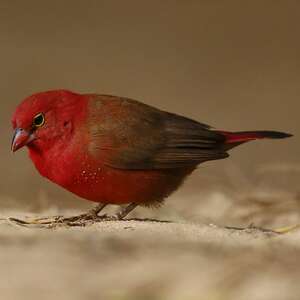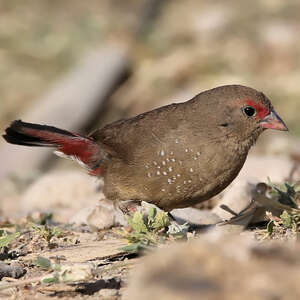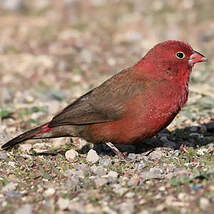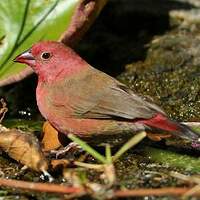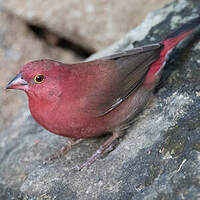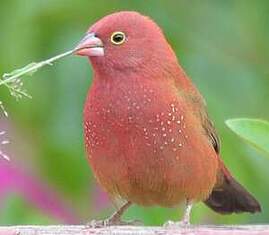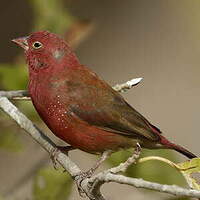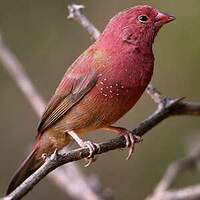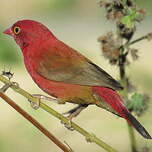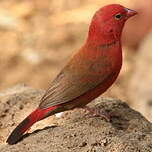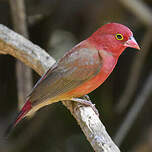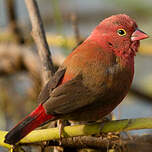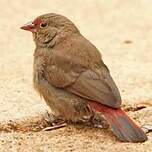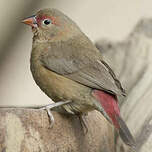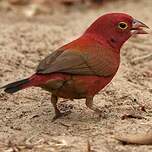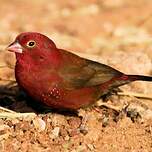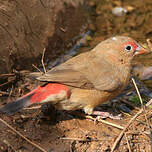Red-billed Firefinch
Lagonosticta senegala - Amarante du Sénégal
Identification
The Red-billed Firefinch of Senegal has a very pronounced sexual dimorphism. The adult male is differentiated from the female by its predominant red colouring. The head and chest are scarlet red. The crown and nape can be slightly brown. Small white spots are visible on the sides of the chest, with their intensity varying individually. The small, conical beak is pink or red, darkened on top, underneath and at the commissure. The eye is dark brown and the eye is surrounded by a light yellow, greenish orbital ring, outside of the breeding season. The mantle, back are light brown-mottled, the wings of the same shade but much darker. The flight feathers are sometimes tinged red. The rump and upper tail coverts have the bright red colour of the head. The tail feathers are dark brown. The under tail coverts are light brown to grey. The legs are pinkish gray.
In the female, the red of the male is replaced by yellow, except on the loral and supra-ocular areas, the rump and the upper tail coverts, which are red. The back is brown-beige shaded with yellow, the head lighter than the body. The underside is a little lighter and more yellow. Small white spots can also be seen on the sides of the chest, usually more extended on the sides than in the male. The beak is pinkish or even yellowish. The orbital ring is white or gray.
The juvenile is very similar to the adult female but does not have any red on the head, or any white spots on the chest or sides. Its beak is black.
Subspecific information 6 subspecies
- Lagonosticta senegala senegala (Mauritania, Senegal and Gambia to w and c Nigeria)
- Lagonosticta senegala rhodopsis (e Nigeria, n and c Cameroon and s Chad to Sudan, w Eritrea and w Ethiopia)
- Lagonosticta senegala brunneiceps (c Ethiopia and se Sudan)
- Lagonosticta senegala somaliensis (se Ethiopia and s Somalia)
- Lagonosticta senegala ruberrima (DRCongo, Uganda and w Kenya to ne Angola, ne Zambia and n Malawi)
- Lagonosticta senegala rendalli (s Angola to Mozambique south to South Africa)
Foreign names
- Amarante du Sénégal,
- Amaranta senegalesa,
- peito-de-fogo-de-bico-vermelho,
- Senegalamarant,
- vöröscsőrű tűzpinty,
- Vuurvinkje,
- Amaranto beccorosso,
- rödnäbbad amarant,
- Rødnebbamarant,
- amarant červenozobý,
- amarant rudozobý,
- Amarant,
- ruusupeippo,
- Rooibekvuurvinkie (Rooibekrobbin),
- amaranta del Senegal,
- Logastrildi,
- amarantka czerwonodzioba,
- sarkanknābja ugunsžubīte,
- amaranta,
- Обыкновенный амарант,
- コウギョクチョウ,
- 红嘴火雀,
- rödnäbbad amarant,
- 紅嘴火雀,
Voice song and call
The usual contact call is a rising, fluted pii often repeated. It can acquire a rolling tone and then sound similar to the Common Chaffinch's call. The alarm call is a sharp chic usually given in series. The song starts with a strong puit followed by softer, fluted notes resembling chirps.
Habitat
The Red-billed Firefinch inhabits open wooded savanna with a dense herbaceous stratum, surrounding shrubby thickets and open areas for foraging on the ground. Its granivorous diet thus leads it to settle near water bodies, wet meadows or marshy areas with all the succulent grasses available there. It is also attracted to anthropogenic habitats, the outskirts of villages and the crops they enclose. It can even be found in urban areas, where it enjoys waste dumps and ruderal plants.
Behaviour character trait
The Red-billed Firefinch is a gentle and trusting species. In pairs or small variable-sized groups, it is often seen with other Estrildidae species such as the Red-cheeked Cordon-bleu.
Groups can be large outside of the breeding season.It mainly feeds on the ground in open areas, but close to sheltering bushes allowing it to glean seeds safely on the ground. It moves around hopping. Occasionally, it can also be seen picking seeds from the tip of tall grass, in a similar way to a Cut-throat Finch, for example.
Flight
Dietfeeding habits
The Red-billed Firefinch is a granivore that feeds on the ground in pairs or small groups of small-sized herbaceous seeds (annual plants, grasses, etc.) (1 to 2 mm in diameter), seeds of cultivated plants such as millet in agricultural areas. In Ethiopia, it also feeds on the very small seeds of the cultivated teff. Small insects are consumed, including termites. The young in the nest are fed animal prey before switching to a granivore diet after flight.
Reproduction nesting
Red-billed Firefinch breeding can take place throughout the year, but it is correlated to local rainfall.
The bird mostly breeds during the rainy season when it is available. For example, in Kenya, it can nest all year round, but preferentially from March to June, the main rainy season.The breeding pair isolate themselves from the group, but multiple pairs may group together to nest when the places are favorable. The mating display performed by the male is very expressive. A feather in the beak, it flies with a high-pitched buzzing of the wings. Then, perched, it raises its head backwards, lifting its body and hopping on its feet.
The nest is built inside a bush, in a tree, in a thatched roof, or even on the ground. It has the shape of a dome with a lateral entrance. Its roof is made of dry grass and protects a flattened cup lined with feathers. The female lays 3 to 5 eggs which will be incubated by both partners for 11 to 12 days from the last egg. The young are fed mainly with insects for 18 to 19 days. After flying, they remain dependent for about ten days on their parents who feed them with regurgitated seeds.
The species is parasitized by the Red-billed Firefinch Senegal Bushbaby which imitates the voices of adults but also of young Firefinches.
Geographic range
The Red-billed Firefinch is found and breeds throughout most of sub-Saharan Africa. Movements of the species are local and occur during the dry season. The species, which was introduced to Egypt, is now extinct there. In Algeria, however, it is spreading northwards.
This species is increasingly kept in captivity.
Threats - protection
IUCN conservation status
concern
in the Wild
threatened
evaluated
The Red-billed Firefinch is common and is generally not threatened. Its populations are locally abundant throughout Sub-Saharan Africa. Up to 140 individuals per km2 have been counted in some places.
Despite this, the modification of its habitat can still affect its populations. For example, in the middle of last century, thatched roofs were replaced in Kenya with metal roofs, resulting in a decrease in the population of the species.
Sources of information
- IOC World Bird List (v15.1), Gill, F and D Donsker (Eds). 2025-12-07.
- Finches and Sparrows, Peter Clement
- HBW Alive,
Other sources of interest
 Specification sheet created on
21/07/2023 by Nathalie Santa Maria
Specification sheet created on
21/07/2023 by Nathalie Santa MariaTranslation by AI Oiseaux.net
© 1996-2025 Oiseaux.net
- Accipitriformes
- Aegotheliformes
- Anseriformes
- Apodiformes
- Apterygiformes
- Bucerotiformes
- Caprimulgiformes
- Cariamiformes
- Casuariiformes
- Charadriiformes
- Ciconiiformes
- Coliiformes
- Columbiformes
- Coraciiformes
- Cuculiformes
- Eurypygiformes
- Falconiformes
- Galliformes
- Gaviiformes
- Gruiformes
- Leptosomiformes
- Mesitornithiformes
- Musophagiformes
- Nyctibiiformes
- Opisthocomiformes
- Otidiformes
- Passeriformes
- Pelecaniformes
- Phaethontiformes
- Phoenicopteriformes
- Piciformes
- Podargiformes
- Podicipediformes
- Procellariiformes
- Psittaciformes
- Pterocliformes
- Rheiformes
- Sphenisciformes
- Steatornithiformes
- Strigiformes
- Struthioniformes
- Suliformes
- Tinamiformes
- Trogoniformes



